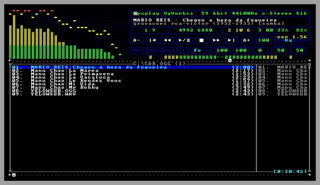Windows Media Audio (WMA) is a series of audio codecs and their corresponding audio coding formats developed by Microsoft. It is a proprietary technology that forms part of the Windows Media framework. WMA consists of four distinct codecs. The original WMA codec, known simply as WMA, was conceived as a competitor to the popular MP3 and RealAudio codecs. WMA Pro, a newer and more advanced codec, supports multichannel and high resolution audio. A lossless codec, WMA Lossless, compresses audio data without loss of audio fidelity. WMA Voice, targeted at voice content, applies compression using a range of low bit rates. Microsoft has also developed a digital container format called Advanced Systems Format to store audio encoded by WMA.

Windows Media Player (WMP) is the first media player and media library application that Microsoft developed to play audio and video on personal computers. It has been a component of the Microsoft Windows operating system, including Windows 9x, Windows NT, Pocket PC, and Windows Mobile. Microsoft also released editions of Windows Media Player for classic Mac OS, Mac OS X, and Solaris, but has since been discontinued them.
Windows Media Video (WMV) is a series of video codecs and their corresponding video coding formats developed by Microsoft. It is part of the Windows Media framework. WMV consists of three distinct codecs: The original video compression technology known as WMV, was originally designed for Internet streaming applications, as a competitor to RealVideo. The other compression technologies, WMV Screen and WMV Image, cater for specialized content. After standardization by the Society of Motion Picture and Television Engineers (SMPTE), WMV version 9 was adapted for physical-delivery formats such as HD DVD and Blu-ray Disc and became known as VC-1. Microsoft also developed a digital container format called Advanced Systems Format to store video encoded by Windows Media Video.

Advanced Systems Format is Microsoft's proprietary digital audio/digital video container format, especially meant for streaming media. ASF is part of the Media Foundation framework.

A playlist is a list of video or audio files that can be played back on a media player either sequentially or in a shuffled order. In its most general form, an audio playlist is simply a list of songs, but sometimes a loop. The term has several specialized meanings in the realms of television broadcasting, radio broadcasting and personal computers.
Windows Media is a discontinued multimedia framework for media creation and distribution for Microsoft Windows. It consists of a software development kit (SDK) with several application programming interfaces (API) and a number of prebuilt technologies, and is the replacement of NetShow technologies.
M3U is a computer file format for a multimedia playlist. One common use of the M3U file format is creating a single-entry playlist file pointing to a stream on the Internet. The created file provides easy access to that stream and is often used in downloads from a website, for emailing, and for listening to Internet radio.
PLS is a computer file format for a multimedia playlist. It is typically used by media players for streaming media over the Internet, but may also be used for playing local media.
XML Shareable Playlist Format (XSPF), pronounced spiff, is an XML-based playlist format for digital media, sponsored by the Xiph.Org Foundation.
The Hauppauge MediaMVP is a network media player. It consists of a hardware unit with remote control, along with software for a Windows PC. Out of the box, it is capable of playing video and audio, displaying pictures, and "tuning in" to Internet radio stations. Alternative software is also available to extend its capabilities. It can be used as a front-end for various PVR projects.
Webjay was a web-based playlist service launched in early 2004. Playlists consisted of links to Vorbis, MP3, WMA, RealAudio and/or other audio files on the web. Webjay users could create new playlists by copying from existing playlists, or by web scraping audio file links from external web pages or playlists. The site was created by Lucas Gonze.

Flip4Mac from Telestream, Inc. was a digital media software for the macOS operating system. It was known for being the only QuickTime component for macOS to support Windows Media Video, and was distributed by Microsoft as a substitute after they discontinued their media player for Macintosh computers.

K-Multimedia Player is an Adware-supported media player for Windows and iOS that can play most current audio and video formats, including VCD, HDML, DVD, AVI, MKV, Ogg, OGM, 3GP, MPEG-1/2/4, AAC, WMA 7, 8, WMV, RealMedia, FLV and QuickTime. KMPlayer shows many advertisements, including in the homepage, side panels, options panel, and as pop-up ads.

GOM Player is a media player for Windows, developed by GOM & Company. With more than 100 million downloads, it is also known as the most used player in South Korea. Its main features include the ability to play some broken media files and find missing codecs using a codec finder service.
Synchronized Accessible Media Interchange (SAMI) is a Microsoft accessibility initiative released in the summer of 1998. The structured markup language is designed to simplify creating subtitles for media playback on a PC.
WPL is a computer file format that stores multimedia playlists. It is a proprietary file format used in Microsoft Windows Media Player versions 9–12. The elements of WPL files are represented in XML format. The top-level element, smil, specifies that the file's elements follow the SMIL structure.

Mpxplay is a 32-bit console audio player for MS-DOS and Windows. It supports a wide range of audio codecs, playlists, as well as containers for video formats. The MS-DOS version uses a 32-bit DOS extender.
In computing, Open Data Protocol (OData) is an open protocol that allows the creation and consumption of queryable and interoperable REST APIs in a simple and standard way. Microsoft initiated OData in 2007. Versions 1.0, 2.0, and 3.0 are released under the Microsoft Open Specification Promise. Version 4.0 was standardized at OASIS, with a release in March 2014. In April 2015 OASIS submitted OData v4 and OData JSON Format v4 to ISO/IEC JTC 1 for approval as an international standard. In December 2016, ISO/IEC published OData 4.0 Core as ISO/IEC 20802-1:2016 and the OData JSON Format as ISO/IEC 20802-2:2016.

Clementine is a free and open-source audio player. It is a port of Amarok 1.4 to the Qt 4 framework and the GStreamer multimedia framework. It is available for Unix-like, Windows and macOS operating systems. Clementine is released under the terms of the GPL-3.0-or-later.
Unreal Media Server is a streaming server software created by Unreal Streaming Technologies.




